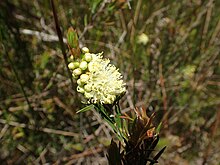| River bottlebrush | |
|---|---|

| |
| Melaleuca paludicola | |
| Scientific classification | |
| Kingdom: | Plantae |
| Clade: | Tracheophytes |
| Clade: | Angiosperms |
| Clade: | Eudicots |
| Clade: | Rosids |
| Order: | Myrtales |
| Family: | Myrtaceae |
| Genus: | Melaleuca |
| Species: | M. paludicola |
| Binomial name | |
| Melaleuca paludicola Craven | |
| Synonyms | |
Melaleuca paludicola, commonly known as river bottlebrush, is a plant in the myrtle family Myrtaceae, and is endemic to eastern Australia. (Some Australian state herbaria continue to use the names Callistemon sieberi or Callistemon paludosus.) It is a shrub or small tree with flexible, often drooping branches, pinkish new growth and spikes of cream, pale yellow, or sometimes pink flowers in summer.
Description
Melaleuca paludicola is a shrub or tree growing to 8 m (30 ft) tall, with fibrous bark, or hard, fissured bark on older plants. Its leaves are arranged alternately and are 20–68 mm (0.8–3 in) long, 1.3–8 mm (0.05–0.3 in) wide, flat, linear to narrow lance-shaped and have a small point at the end. There is a distinct mid-vein and 11–18 indistinct side veins.
The flowers are a shade of cream to yellow, occasionally pink and are arranged in spikes on the ends of branches which continue to grow after flowering and also on the sides of the branches. The spikes are 20–30 mm (0.8–1 in) in diameter with 10 to 40 individual flowers. The petals are 2.6–4.2 mm (0.1–0.2 in) long and fall off as the flower ages and there are 48–67 stamens in each flower. Flowering occurs mainly from October to January and is followed by fruit which are woody, cup-shaped capsules, 3–4.3 mm (0.1–0.2 in) long.

Taxonomy and naming
Melaleuca paludicola was named in 2006 by Lyndley Craven in Novon when he transferred Callistemon sieberi to the present genus. Callistemon sieberi was first formally described by botanist Augustin Pyramus de Candolle in 1828 in Prodromus Systematis Naturalis Regni Vegetabilis. The specific epithet (paludicola) is from the Latin word palus meaning “swamp”, "marsh", "bog" or "fen" and the suffix -cola meaning “inhabitant”. An earlier, alternative name (taxonomic synonym) for the species was Callistemon paludosus and the present name was chosen to link with the earlier one.
Callistemon paludosus is regarded as a synonym of Melaleuca paludicola by the Royal Botanic Gardens, Kew.
Distribution and habitat
Melaleuca paludicola occurs from Warwick in the far south east of Queensland, through New South Wales as far inland as the eastern part of the North West Plains to the eastern half of Victoria. There is a disjunct population in the Mount Lofty Ranges and Adelaide districts of South Australia. It grows in and near rivers, in dry, rocky riverbeds and in flood channels subject to periodic inundation.
Use in horticulture
Melaleuca paludicola is sometimes cultivated as Callistemon sieberi. An alpine form is a smaller, denser, rounded shrub suitable as a more formal plant.
Gallery
-
 In the Royal Botanic Gardens, Melbourne as Callistemon sieberi
In the Royal Botanic Gardens, Melbourne as Callistemon sieberi
-
 Leaves and fruit
Leaves and fruit
-
 Leaves and flowers
Leaves and flowers
References
- ^ "Melaleuca paludicola". Plants of the World Online. Retrieved 5 September 2021.
- Udovicic, Frank; Spencer, Roger (2012). "New combinations in Callistemon (Myrtaceae)" (PDF). Muelleria. 30 (1): 23–25. doi:10.5962/p.292240. S2CID 251007557. Retrieved 11 June 2015.
- ^ Brophy, Joseph J.; Craven, Lyndley A.; Doran, John C. (2013). Melaleucas : their botany, essential oils and uses. Canberra: Australian Centre for International Agricultural Research. p. 267. ISBN 9781922137517.
- ^ Spencer, Roger; Lumley, Peter F. "Callistemon sieberi". Royal Botanic Garden Sydney: Plantnet. Retrieved 15 July 2015.
- ^ "Callistemon sieberi" (PDF). Corangamite Seed Supply and Revegetation Network. Retrieved 25 January 2018.
- "Melaleuca paludicola". APNI. Retrieved 15 July 2015.
- Craven, Lyn A. (2006). "New Combinations in Melaleuca for Australian Species of Callistemon (Myrtaceae)". Novon. 16 (4): 472. doi:10.3417/1055-3177(2006)16[468:NCIMFA]2.0.CO;2. S2CID 84723155. Retrieved 15 July 2015.
- "Callistemon sieberi". APNI. Retrieved 25 January 2018.
- de Candolle, Augustin Pyramus (1828). Prodromus Systematis Naturalis, Volume 3Regni Vegetabilis. Paris. p. 223. Retrieved 21 July 2015.
- ^ Brown, Roland Wilbur (1956). The Composition of Scientific Words. Washington, D.C.: Smithsonian Institution Press.
- ‹ The template below (WCSP) is being considered for deletion. See templates for discussion to help reach a consensus. ›
"Callistemon paludosus". World Checklist of Selected Plant Families (WCSP). Royal Botanic Gardens, Kew.
- Wrigley, John W.; Fagg, Murray (1983). Australian native plants : a manual for their propagation, cultivation and use in landscaping (2nd ed.). Sydney: Collins. p. 193. ISBN 0002165759.